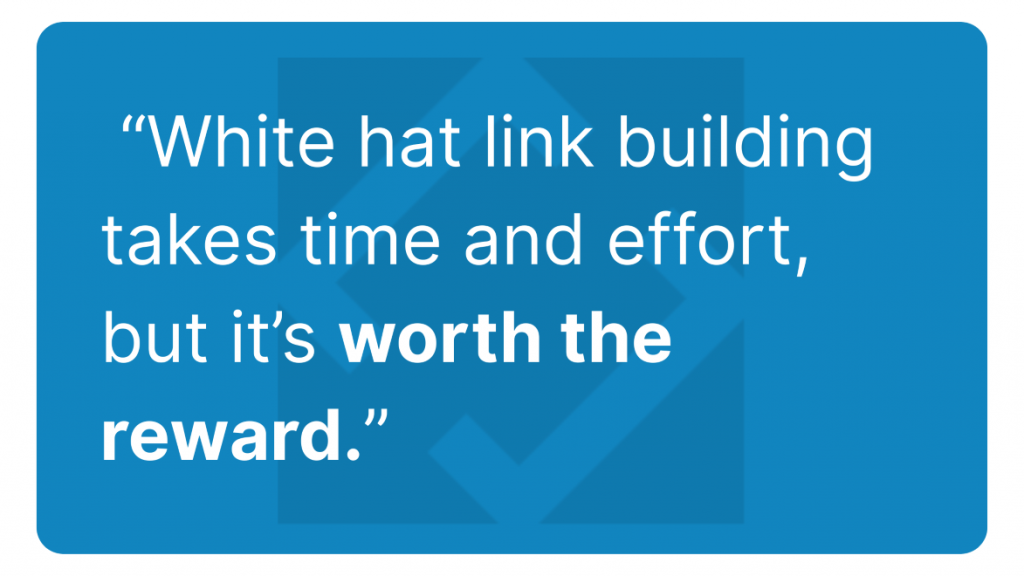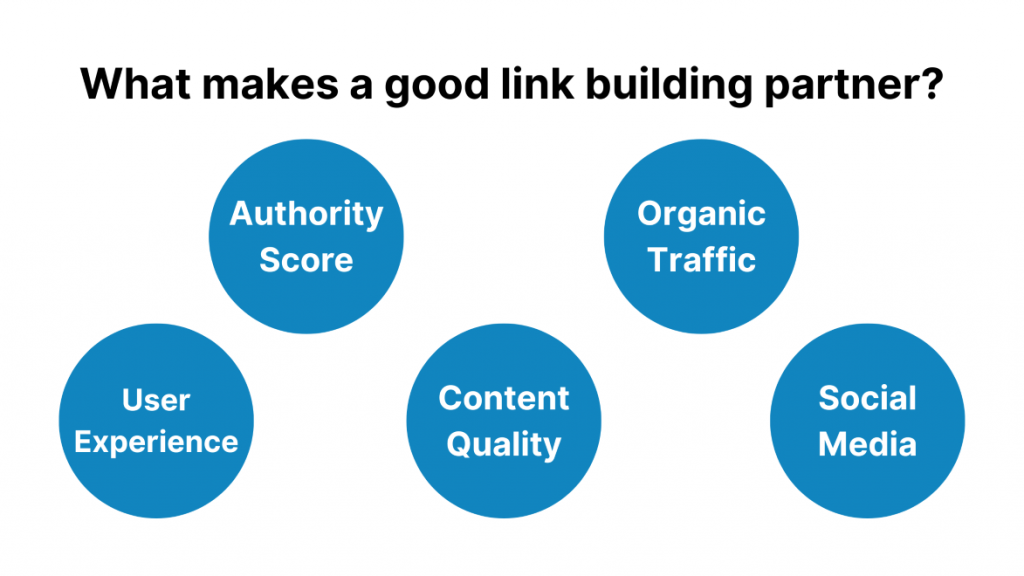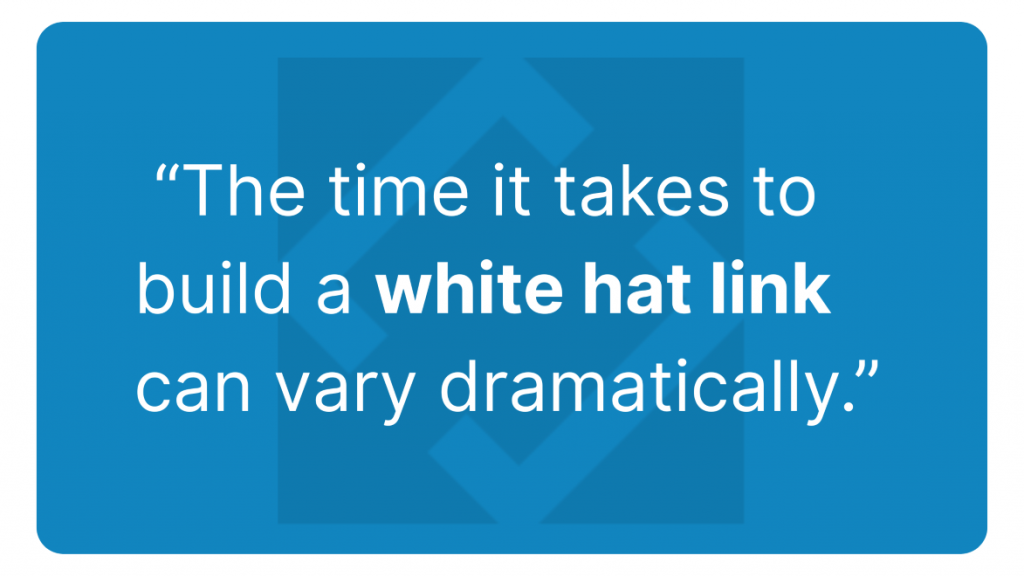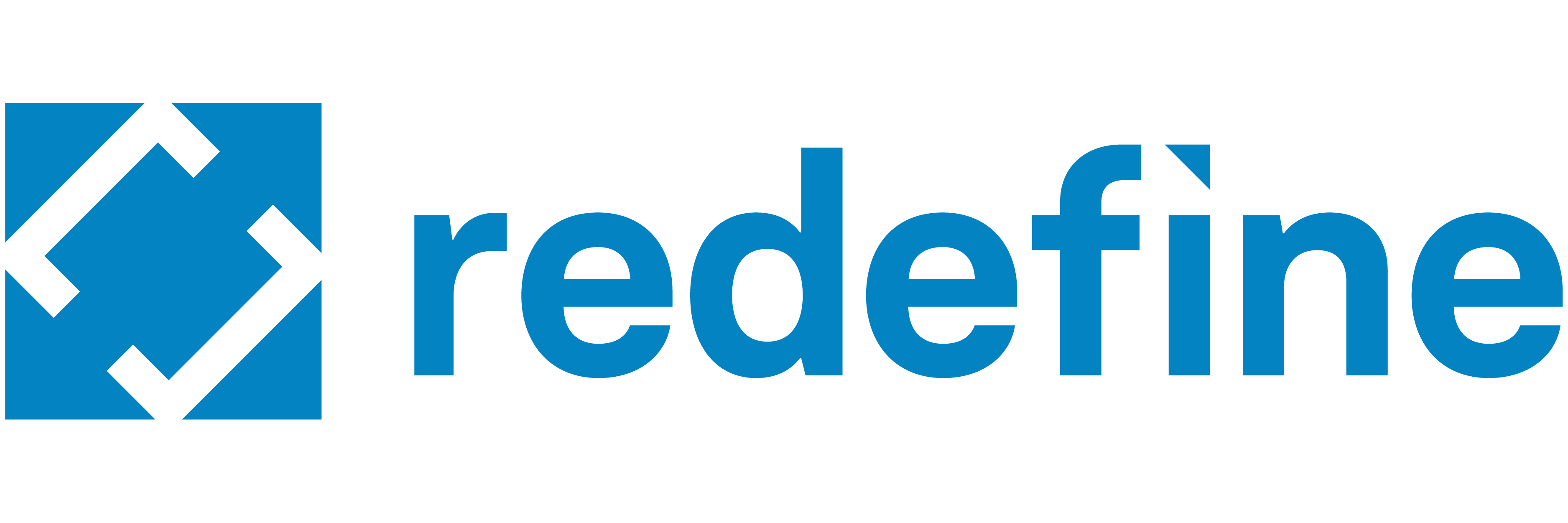- Building white hat links takes effort and, most importantly, time.
- With Google laying out guidelines for good and bad links, finding the right ones is crucial.
- White hat link building can be easy or challenging, depending on the industry you’re working in.
- When looking for sites to build white hat links with, we consider authority score, user experience, content guidelines, and other factors.
- Ultimately, it can take anywhere from ten to 48 hours to build a white hat link.
In the world of SEO, link building has become a staple tactic in organic search strategies across various industries. When reputable third-party websites link back to you, search engine algorithms see this as a vote of confidence. These links are known as “backlinks” – and the more back links you have, the more likely Google will rank you higher on SERPs. Link building takes time and effort, but it’s worth the reward.
But not all links are created equal! In the early years of SEO, all back links were considered one and the same. Though, like everything in organic search life, they become abused by marketers and SEOs, and Google is forced to strike down its hammer and lessen the tactic’s importance.

Good links vs. bad links
Nowadays, because of Google’s increasingly strict guidelines around link building, there are clear (or, as clear as Google makes it) differences between good links and bad links.
What’s the difference between good links and bad links? One simple definition is that good links are ones that you earn, organically, while bad links are ones that you pay for. Good (white hat) links take time, effort, and lots of skill. Bad (black-hat) links are easy wins, take little effort, and require no skill.
Again, not all links are created equal. The time, effort, and skills required to build a high-quality, white hat link vary by industry or niche. In this article, we’ll dive deeper into what’s considered a white hat link, how long it takes to build one (by industry), and some tips for building white links!
What is white hat link building?
So let’s first start by explaining what white hat link building really is. And, no, it’s not doing link building while wearing a white cowboy hat! White hat link building is a process of securing backlinks for your website in a legitimate, ethical manner that complies with Google’s Webmaster Guidelines (or the guidelines of other search engines).
White hat links are obtained organically. They are not bought or manipulated in any way. Getting these links takes time, effort, and tons of skill to build. White hat link building typically involves creating high-quality content that is relevant to the website and its target audience. That content is then promoted among relevant websites, press, or influencers in the industry.
The goal of white hat link building is to improve a website’s search engine rankings and increase its visibility online, while maintaining the website’s integrity and reputation. By using ethical “by-the-book” link-building techniques, a website can improve its chances of long-term SEO success while avoiding Google penalties.
Link building partners: what to consider
So how long does white hat link building take? Before we can answer this question, let’s talk a little bit about the data – and our methodology for choosing the right partner sites for outreach.
These hour calculations are based on our 2022 outreach efforts across 20 clients in medical, marketing, e-commerce, software, legal services, home improvement, franchising, and manufacturing.
At Redefine, our standards for link building are pretty high. We typically look at these data points before deciding if we should collaborate with a site:

Authority score
For us, the authority score is an indicator of the SEO value of a site. It gives us a quick idea of how healthy a site is. The higher the score, the less likely the site will have technical errors, low-quality content, or other issues that could reflect poorly.
Estimated organic traffic/keyword history
The history of a site’s organic traffic gives us an idea of whether or not a site has been affected negatively by algorithm updates or penalties from Google in the past. We also look at their keyword history. If they have recently lost many rankings, it may indicate technical issues or other problems with their site. Alternately, recently gained keywords indicate a healthy site that’s on the rise.
The user experience of a website
User experience can affect both how users and Google perceive the trustworthiness of a site. Since trustworthiness and user experience are both ranking factors, we want to ensure that any websites we collaborate with have the trust of their users.
Rigorous content guidelines
High content standards simply tell our link building team the minimum acceptable quality of content a blog or website accepts. We ask ourselves, “Are they just allowing any Tom, Dick, and Harry to post? Or are they reserving their blog for excellent writers with topical authority and expertise?”
Social media activity and presence
Here, we are mostly looking to see if they have social media profiles linked in their footer and if they’ve amassed a following on social media. This can lend a hand to the quality of their content and the level of engagement of their audience.
Link building timelines: what to expect
The truth is that the time it takes to build a white hat link can vary dramatically; some links are much easier to build than others. Factors like industry trends, email timing, and content quality all affect your link building efforts.
It also depends on whether you’re creating content – like a guest post – or simply getting a link included in a list or pre-written article. If you’re writing a guest post, it may be a more time-consuming process because you’ll be corresponding with editors and publishers.
Plus, link building isn’t the same across all industries. Some industries are easy to build links in, others are outright difficult! A few of our clients operate within very popular niches, where content is in high-demand. When we pitch topics or content around these clients, we’ll get more enthusiastic responses: “You’re going to write me an article on password-less authentication?! I’ll take it; that’s a fun topic!” or “Wow, incredible article! I’ll link to it in my next post.”

Some industries are also easier because the prominent voices within those industries understand the importance of links. For example, online publications focused around tech, startups, or SaaS tend to be digitally savvy and recognize how link building is beneficial to both parties.
On the other hand, link building can take longer when the client’s industry is very small and limited to a handful of online outlets that cover it. Some publications also get bombarded with link building requests and automatically decline them.
Now, this may seem discouraging to some – because who in the world wants to spend 30+ hours building a single link? But this is the reality of using cold outreach to build links. It takes tons of time and effort – and coordination between multiple departments – to build a single link for a client.
But when done correctly, white hat links provide valuable SEO equity that helps your business outrank the competition.
White hat link building tips
As you’ve seen, white hat link building isn’t the quickest or easiest SEO tactic. Securing high-quality backlinks that are aligned with Google’s webmaster guidelines takes time and energy.
While there are no shortcuts with link building, we’ve discovered tips for building white hat links that can help boost your success:
- Create high-quality, informative content for humans (not just search engines)
- Have strong link-building guidelines within your internal strategy
- Look for websites with a strong social media presence
- Collaborate with sites with strong editorial guidelines
- Adhere as closely as possible to Google’s webmaster guidelines
Create content worth linking to
Even the best link building strategy will fall flat if you don’t create high-quality content to link back to. When you have strong content that adds value to the reader, other websites will be excited to link to it. So what kinds of content should you create to increase your backlinks?
Go beyond a standard blog article and try making content such as:
“How To” guides
A “How To” guide is a simple yet powerful piece of content that can encourage other websites to link back to you. Also known as a step-by-step guide, these articles take a concept or process and break it down into digestible pieces that anyone can understand. They’re highly shareable because they’re easy to reference.
Think about your product, service, or industry – what problems do you solve for consumers? This is a great question to help you get started. For example, if you sell cookware, an excellent guide could be called, “How to Clean and Care for Cast Iron Pans.”
Interactive content
Interactive content also encourages back links. This content could be a tool such as a quiz to help customers find the right product based on their needs and preferences, calculators for converting measurements, or entertaining content such as a game or virtual puzzle.
Whether your interactive content is utilitarian or simply generates buzz, it should be a unique offering. When people discover your interactive content, they’ll want to share it – and include a link on their own blog or website.
Original survey data
Statistics are one of the most-linked types of content on the internet. That’s because hard data provides context and credibility. When writers cite a statistic and link back to the original source, it shows they’ve done their due diligence. If your website can publish statistical data, you’ll become the expert authority that others link to.
While you may not have the time or money to launch an industry-wide study, user surveys are an easy way to gather statistics. Consider polling your customers about their habits or behaviors. Although you might have a relatively small sample size, you can publish the results in an exclusive article to share with others in your industry.
Case studies
Case studies are similar to surveys and polls. While the latter focuses on quantitative data, case studies include qualitative information as well. Case studies provide unique industry insights or prove the efficacy of your product or service. This encourages backlinks by others.
When designing a case study, present relevant data in charts or graphs that are easy to understand. Use customer testimonials, too. Other content creators may cite your case study in quotations and link back to you.
Be as original as possible
Be original. No matter what type of link building content you create, it should be one-of-a-kind. Stay true to your brand’s voice and emphasize your value propositions. When you offer content that can’t be found elsewhere – whether it’s a step-by-step guide or the results of a survey you conducted – anyone who uses your information will have to link back to you.
Also, we recommend human-written content over AI. While tools like ChatGPT can help you research and outline, don’t just copy and paste an AI-written article and call it a day. Link building content needs to be natural, easy to read, and highly engaging. AI-written content rarely flows as well as content written by an actual person. If you’re submitting a guest post, you also need to make sure that your content can pass plagiarism detection software.
Don’t have time to build white hat links?
Link building isn’t an easy sport! There’s a reason why 52% of digital marketers say link building is the most difficult part of SEO campaigns. As you’ve seen, link building requires lots of time, effort, and persistence. It’s really a long game, but when played right, it can produce long-term SEO success for your website.
If you don’t have the time to spend link building, then look no further than the team here at Redefine. Our link-building experts will create a link-building campaign that generates SEO success for years to come.





